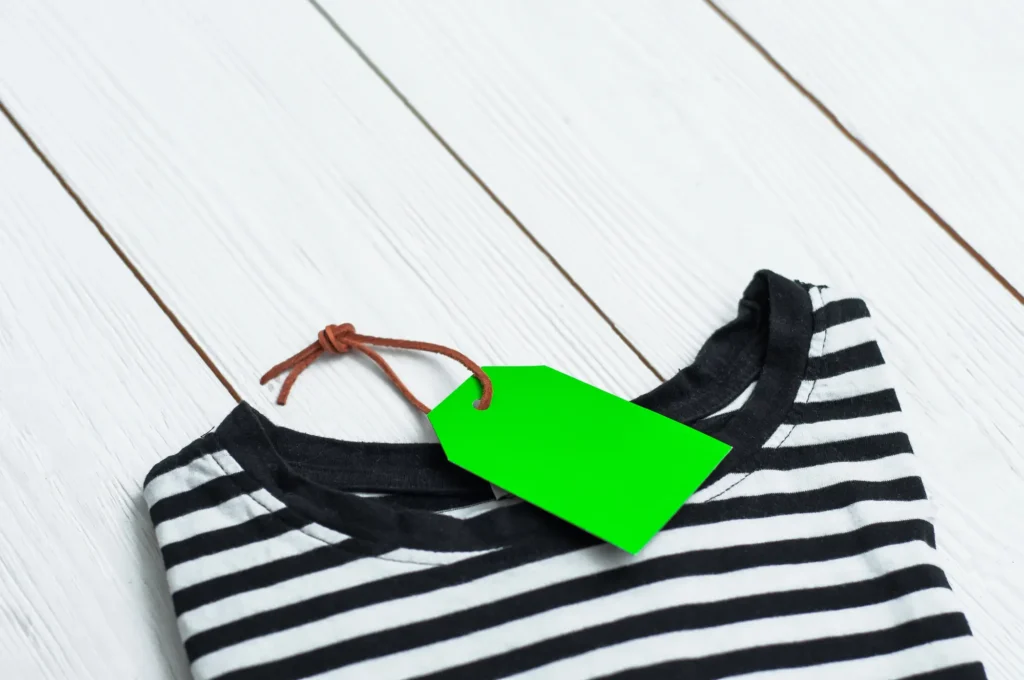In the dynamic world of fashion, where anyone can become both a seller and a buyer, the Vinted platform is becoming an increasingly important player in the used clothing market. With each passing day, its virtual shelves are yielding to the weight of new offerings, among which there is no shortage of either gems or fakes of well-known brands. It is here, in this digital microcosm, that our purchasing decisions can carry much broader consequences.
Table of contents
- Informed choice portal
- How to buy on Vinted?
- Benefits of buying used clothing
- Fraud warnings
- How to recognize and avoid suspicious offers? How to deal with fraud?
- When is there a tag and when is there not?
- Ask the seller
- Learn more about the brand
- Learn to recognize materials
- Check reviews
- “New without tag” filter
- Maintaining security on the Vinted platform. How to minimize the risk?
Informed choice portal
For the conscious user who wants not only to refresh his or her closet, but also to follow the principles of sustainability, the portal offers a unique opportunity. However, this opportunity comes with responsibility. When we go shopping, we face a challenge: can we distinguish between an authentic product and a fake? Are we able to assess whether our purchase will contribute to the growth of the gray purchasing market?
The editors recommend: How to search for a good women’s sweater with quality composition? Fashion advice.
In this context, Vinted is not just a transaction platform – it becomes a field for informed choice. Every purchase, every decision to add another item to the cart, is part of a broader environmental and ethical context. In an era where consumerism is reaching its apogee, choosing used clothing from Vinted can be a conscious step toward minimalism and responsibility for the planet. However, we need to be vigilant and well-informed for our intentions to work. Knowing how to identify genuine products and avoid counterfeits becomes crucial. When we buy new products on the platform that do not have a clearly defined origin, we may unknowingly support unsustainable practices. Many of these items may be the result of overproduction, which is one of the main problems in today’s fashion industry, leading to waste of resources and environmental pollution.
Therefore, as informed consumers, we should carefully scrutinize every purchase on Vinted, especially avoiding new products of uncertain origin. By choosing used items, we not only give them a second life, but also minimize our carbon footprint and contribute to reducing consumerism. In our article, we will emphasize the importance of ensuring that every choice on the platform is thoughtful and in line with our values, thus helping to build a more sustainable future for the fashion world. So how do we buy on Vinted so that our purchasing decisions are not only informed, but also ethical and ecological?
In the context of ecological awareness and ethical choices, an important aspect of using the Vinted platform is also to consciously avoid buying new products that start to appear next to used ones. Although they are tempting with their low price and intact condition, they very often come from an unknown source and may have questionable composition labels, which calls into question their real value and environmental impact.

How to buy on Vinted?
Buying on Vinted, as on other sales platforms, requires some caution, but it can be done safely, of course, by following a few important rules.
Here are some steps to take to make safe purchases on Vinted:
- Searching offers:
- Use the search filters to narrow the results to the items you are interested in.
- Check the photos of the products carefully to see their condition and any defects.
- Read product descriptions very carefully to make sure you understand what is included in the price (e.g., shipping costs, possible damage).
- Vendor evaluations:
- Pay attention to vendor ratings. The higher the rating, the more likely the transaction will be successful.
- Read other buyers’ reviews of a particular seller. They will help you get an idea of how the vendor handles transactions and what the feedback is on the quality of the products they sell.
- Contact the seller:
- If you have questions about the product, feel free to ask the seller. This can help clarify any doubts before purchase.
- Make sure you are clear about any details of the product, such as size, condition or possible defects.
- Payments:
- Use secure payment methods offered by the platform, such as payment through the app or online platform.
- Avoid making payments outside the official platform to avoid potential scams.
- Buyer Protection:
- Familiarize yourself with Vinted’s returns and complaints policy. Make sure you fully understand your rights as a buyer.
- If you have any doubts about a product, do not hesitate to ask Vinted customer service for help.
- A sensible approach:
- Be reasonable in your purchases. Avoid offers that seem too good to be true, especially if the price is much lower than average.
- Also check the prices of similar products on other platforms to make sure the offer on Vinted is fair.
Benefits of buying used clothing
Buying used clothing brings a number of both financial and environmental benefits.
Here are some of the main benefits of buying used clothing:
- Financial savings:
- One of the most obvious benefits of buying used clothing is saving money. Second-hand products are usually cheaper than new ones, which can save you a significant amount of money, especially if you are looking for brand-name clothes.
- Reducing environmental impact:
- Buying used clothing is an eco-friendly approach because it reduces textile waste. The garment industry generates huge amounts of waste and consumes a lot of natural resources, and buying used clothes helps reduce these negative effects.
- CO2 reduction:
- The production of new clothes involves the emission of carbon dioxide and other greenhouse gases. By buying used clothes, you reduce the need for new products, which in turn reduces the CO2 emissions associated with the production and transportation of new clothes.
- Promoting a closed-loop economy:
- Buying used clothing supports the idea of a closed-loop economy, in which products are used and reused instead of ending up in landfills. This approach helps reduce the amount of waste and resources used to make new clothes.
- Variety of styles:
- When you buy used clothing, you often have access to unique and unusual styles that are hard to find in new clothing stores. You can discover real gems and express your individual style.
- Improving working conditions:
- By reducing demand for new clothes, you can help ease the pressure for fast and cheap production, which can lead to improved working conditions in the garment industry, especially in developing countries.

Fraud warnings
There is a risk of fraud on platforms such as Vinted, which can involve both buyers and sellers.
Here are some common scam schemes to watch out for on Vinted:
- Fake accounts and offers:
- People who create fake accounts may list products they do not own or offer products that do not match the description. They can also use attractive pricing to attract buyers’ attention.
- Phishing:
- Scammers may try to obtain sensitive data, such as login credentials, passwords or credit card information, by sending fake emails or messages on the Vinted platform. They may ask you to click on suspicious links or share sensitive data under the pretext of confirming an order or updating your account.
- Inappropriate product descriptions:
- Some sellers may deliberately mislead buyers through vague or false product descriptions, hiding defects or shortcomings that may exist.
- Non-delivery or products unfit for shipment:
- There is a risk that sellers may not send the product after receiving payment or may send a product that does not match the description or is in poor condition.
- Off-platform payments:
- Scammers may also try to get buyers to make payments outside the Vinted platform, making it impossible to get the protection the platform offers in case of problems with the transaction.
How to recognize and avoid suspicious offers? How to deal with fraud?
- Check the vendor’s ratings and reviews:
- Before making a purchase, check the ratings and reviews of other users on a particular vendor. If a vendor has a lot of negative reviews or a lack of ratings, you may want to consider continuing the transaction.
- Closely analyze product descriptions and photos:
- Read product descriptions very carefully and look at photos with special attention. Check listings where the description is vague or inadequate and the photos are out of focus or look like they were downloaded from the Internet.
- Avoid overly attractive offers:
- Be wary of offers whose price seems too low to be true, especially if it involves brand-name or high-quality products.
- Use secure payment methods:
- Make payments only through secure payment methods offered by the Vinted platform, such as payment by card or through the in-app payment system. Avoid making payments outside the platform.
- Pay attention to communication with the vendor:
- If something seems suspicious when communicating with a vendor (such as a request to make a payment outside the platform), abandon the transaction and report it to the platform administration.
- Consider using the tracking option:
- If you make a purchase and are concerned about its safe delivery, consider using the tracking option. This will help you monitor the status of your shipment and confirm its receipt.
- React immediately if you suspect fraud:
- If you suspect that you have become a victim of fraud, immediately contact the administration of Vinted and report the incident. The sooner you do this, the better the chance of solving the problem and getting your money back.
Remember that the key to avoiding scams on Vinted is to be vigilant, carefully analyze listings and use the secure payment methods offered by the platform. If something seems suspicious to you, it is better to be cautious and not take risks.
Read also: Plus Size dresses that slim down – how to choose a fashionable size and cut to feel good
When is there a tag and when is there not?
By paying attention to clothing tags, you can gain a lot of valuable information that will help you make an informed choice when shopping on the Vinted platform.
Here’s why you should look at the labels:
- Material composition:
- The labels contain information about the material composition of a particular garment. This allows you to judge whether a product is made of natural fibers such as cotton, linen or wool, or synthetic materials such as polyester or nylon. Products made from natural fibers tend to be more environmentally friendly, as they are biodegradable and have less impact on the environment compared to synthetics.
- Care recommendations:
- The labels also contain recommendations for garment care, such as washing temperature, type of detergent and drying method. Following these recommendations can ensure that the garment lasts longer and maintains its quality for a longer period of time.
- Eco-friendliness and sustainability:
- Natural fabrics, such as cotton, linen and wool, tend to be more eco-friendly than synthetics because they are biodegradable and less harmful to the environment. In addition, clothes made of natural fibers are often more durable and resistant to wear and tear than those made of synthetic materials, meaning they can last longer.
- Wearing comfort:
- Products made of natural fibers are often more comfortable to wear because they are breathable and provide better ventilation than synthetics. That’s why it’s worth paying attention to the material composition if you care about the comfort of your clothes.

Ask the seller
A close look at the tags is a key step when shopping on the Vinted platform, but if the information on the tag is illegible or incomplete, it is also worth asking the seller for more details.
Here’s why you should ask questions of the seller:
- Completion of missing information:
- Sometimes the information on the tag may be incomplete or illegible. By asking the seller for additional details, you can get the information you need about size, condition or product details.
- Care and product history:
- By asking questions, you can learn more about the history of the product and how to care for it. For example, if you want to know if a garment has been worn often or how often it has been washed, you can ask the seller about these details.
- Additional photos:
- If you need additional photos of the product to see it from other angles or up close, ask the seller to provide them. This can help you understand the condition and quality of the product more accurately.
- Price Negotiations:
- By asking questions, you can also start price negotiations with the seller. If you have some doubts about the product, you can try to negotiate the price to accommodate any defects or shortcomings.
- Resolution of doubts:
- If you have any doubts about a product, it’s a good idea to clarify them before making a purchase. By asking questions, you can get additional information to help you make a buying decision.
In most cases, sellers on Vinted are open to questions and are happy to provide additional information about their products. By taking advantage of this opportunity, you can provide more certainty about your purchase and avoid potential problems in the future.
Learn more about the brand
Learning more about a clothing brand can be crucial in making purchasing decisions on the Vinted platform. Researching the manufacturer and its production practices can help you assess the quality and sustainability of its garment production approach.
Here are some ways to learn more about the brand:
- Look for information online:
- Conduct online research to learn more about the clothing brand. Visit the brand’s official website and look for reviews and articles about its manufacturing practices and commitment to sustainability.
- A look at the label:
- Look at the label of the garment to see if there is any information about the composition of the material, place of production or organic certification. Some brands may describe their products and production practices in detail on their labels.
- Read opinions and reviews:
- Read other customers’ reviews of the brand and its products. Reviews can provide valuable information about the quality, durability and sustainable approach to garment production.
- Check the commitment to sustainability:
- Look for information on the brand’s commitment to sustainability and ethical manufacturing practices. Brands that actively promote a responsible approach to apparel production often provide information on this topic on their websites.
- Research organic certifications:
- Check if the brand has any organic certifications, such as GOTS (Global Organic Textile Standard) or Fair Trade. Having such certifications can demonstrate a brand’s commitment to producing garments in an environmentally friendly and fair way for workers.
Learn to recognize materials
Learning to recognize different materials is a skill that can be extremely useful when shopping for clothing, both online and in traditional stores.
Here are some tips that can help you learn to identify different fabrics:
- Read the labels:
- Always pay attention to the labels on clothing. They usually contain information on the composition of the material, making it easier to identify the fabrics used.
- Touch and watch:
- Touch different materials to explore their texture and flexibility. You will learn to distinguish between cotton, silk, linen, wool and other materials based on their appearance and tactile sensations.
- Take advantage of online resources:
- There are numerous online resources such as articles, instructional videos and infographics that can help you identify different clothing materials. Use them to expand your knowledge of different fabrics.
- Research your clothing:
- Analyze the garments you already have and try to identify the materials they are made of. Compare different fabrics and pay attention to their characteristics.
- Develop your experience:
- The more time you spend studying different fabrics, the better you will recognize them. Take every opportunity to practice your skills, whether you’re shopping or browsing for your clothes at home.
- Remember the visual cues:
- You can often recognize a material by its appearance and texture. For example, cotton may have fine unevenness, silk is usually smooth and shiny, and wool may have distinctive fibers.
- Exercise regularly:
- Regular practice in recognizing different fabrics will make it easier and more intuitive for you.
Learning to recognize materials is a skill that can be useful not only when shopping for clothes, but also in everyday life. The more you practice, the better you will master this skill.

Check reviews
Carefully reviewing the reviews of other Vinted users can be very helpful when making purchasing decisions.
Here are some reasons why you should check reviews:
- Material quality information:
- Often in reviews you can find information about the quality of the material used in the garment. Customers can share their thoughts on the durability, wearing comfort and overall quality of the fabric.
- Size and fit reviews:
- Reviews often include information on the size and fit of clothes. This can be especially useful if you are in doubt about the right size or cut.
- Purchase experience:
- Customers often share their experiences with the purchase, pointing out positive aspects of the transaction or potential problems they encountered. This can help you assess the credibility of the seller and the quality of the product.
- Overall impressions:
- By reviewing reviews, you can get general impressions of a particular brand, clothing model or retailer. Positive reviews can confirm the quality of a product, while negative reviews can warn of potential problems.
- Tips and Tricks:
- The reviews often also offer useful tips and advice from other users, for example, on caring for clothes or combining them with other items of clothing.
- Diversity of experience:
- By reviewing reviews, you can access a variety of experiences from other users, which can broaden your perspective and help you make a more informed purchasing decision.
“New without tag” filter
This is a feature that allows users of the Vinted platform to find clothes that have never been worn, but for some reason no longer have the original tags. The way it works is that when you apply this filter to a search, you get results that include only those clothes that are described by the seller as new, but do not have a tag.
How does the “New without tag” filter work?
- This filter is ideal for people who want to buy new clothes, but do not want to pay the full retail price. “New without tag” clothes are often offered at lower prices, which can be attractive to bargain seekers.
- Clothes without a tag can come from a variety of sources, such as overproduction, end-of-series, gifts that have never been worn, or clothes that were purchased with the intention of being worn, but ended up staying in the closet.
Is it worth using this filter?
Yes, because it has many advantages.
- Economy:
- “New without a tag” clothes are usually cheaper than those you can buy in a store, even though they have never been used. This allows users to save money by buying clothes in perfect condition, but at a lower price.
- Ecology:
- By choosing new clothes without tags on Vinted, users are helping to reduce clothing waste. By reusing clothes that have never been worn, they are helping to reduce the clothing industry’s negative impact on the environment.
- Be reasonable:
- However, it is important to keep in mind that clothes without labels can come from a variety of sources, including overproduction, end-of-series, and can also be counterfeits. There is also a risk that they may be contraband or untaxed. Therefore, it is important to exercise caution and prudence when making purchases.
Maintaining security on the Vinted platform. How to minimize the risk?
- Verify the seller:
- Before making a purchase, it is worth checking the reviews and comments on the seller’s profile. Users with a good transaction history and positive reviews tend to be more reliable. Review ratings on previous transactions to get a better picture of the seller’s reliability.
- Analyze the offer:
- If an offer seems too attractive to be true (e.g., a very low price for a luxury brand product), this can be a warning signal. Consider whether the price is realistic in the context of the product offered. Remember that a suspiciously low price may indicate an attempted scam.
- Ask questions:
- Do not hesitate to ask the seller questions about the origin of the garment, its condition or history of use. Transparency in responses can be a good indicator of the legitimacy of the product and the integrity of the seller.
- Raise concerns:
- If you come across an offer that seems suspicious or insecure, immediately report it to the platform administrators. By doing so, you will contribute to keeping Vinted a safe place for all users. When in doubt, it is better to be cautious and report suspicions than to risk a fraudulent transaction.
By keeping these rules in mind, you can enjoy shopping on the Vinted platform while minimizing risks and protecting yourself from potential problems. It is important for all of us to act responsibly and remain vigilant when using the platform, as online safety depends on our collective care for ourselves and other users.
Editorial recommends: Power dressing in fashion and women’s fashion





